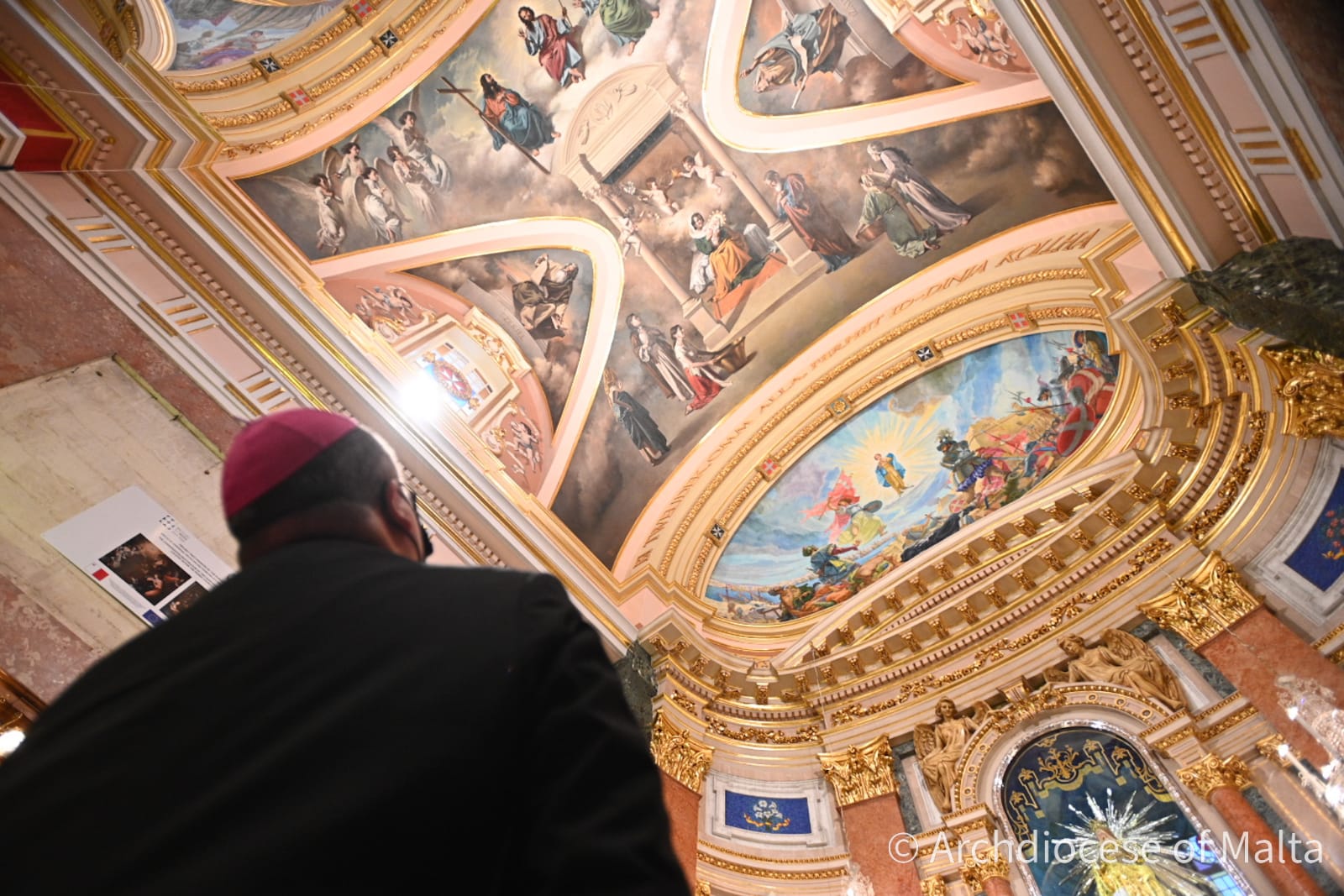On Saturday, 12th June 2021, Archbishop Charles Jude Scicluna inaugurated the new choir painting at the Minor Basilica of the Nativity of Mary, in Senglea.
During the 1930s, parts of the ceiling of the Basilica were painted by the artist Prof. Giuseppe Briffa, followed by a crash due to an air attack during World War II. Some ceiling sectors of the Basilica were painted by the artist Prof. Giuseppe Briffa during the 1930s. An air attack resulted in 80% damages in architecture. Thus, the previous works have been destroyed. After the war, the same artist made an offer to repaint the same ceiling; however, he passed away during the process.

Meanwhile, the Basilica was being decorated, and the desire to finish the ceiling was consistent during the offices of Reverend Archpriest John Sladden and Reverend Archpriest Vincent Cachia. In the Archdiocese’s archives, several petitions regarding the resume of the ceiling painting were found. Artist Frank Portelli painted the dome, the lunettes, and apse; however, history repeated itself as the artist passed away and the procedures have halted.
In 2018, the Reverend Archpriest Robin Camilleri, along with the Chapter requested the approval of the Archdiocese to complete the works by artist Manuel Farrugia. The first phase is done and was inaugurated last Saturday during the year of such importance for the City of Senglea. This year, Senglea is commemorating two centenarians of the Church in Malta: 100th anniversary since the bestowing name of a Basilica and since the Coronation of the celestial and blessed Statue of Marija Bambina.
The vault of the choir of the Basilica of the Nativity of the Virgin Mary at Senglea
The message imparted by the artistic composition on the choir vault is the prophecy of the advent of the Messiah, in which, although indirectly, we find references to Mary. The Virgin represents one of the final preparatory stages for the fulfillment of the mystery of the Incarnation, the main one in Sacred Scripture. The painting on the choir vault recalls the nativity of Mary, which was one of the main steps that led to the birth of Jesus. The insight pervading the decoration project of this and other parts of the basilica is a Marian-Biblical one, which includes episodes from the apocrypha given that some significant episodes from the life of Mary are not found in Sacred Scripture.
On the sides, above the windows, there are two prophets who form part of the Old Testament plan leading to the incarnation; these are Isaiah and Ezekiel. In the books of these prophets, we find the most noteworthy references to the conception and birth of Christ which became a reality through Mary. It was thus appropriate for these two prophets to be depicted there, in the sanctuary of the basilica where the miraculous and devout statue of the Virgin Mary is kept.
Scrolls can be seen in the hands of these prophets; these read: “Therefore the Lord himself will give you a sign. Look, the young woman is with child and shall bear a son, and shall name him Immanuel” (Is 7:14) and “This gate shall remain shut; it shall not be opened, and no one shall enter by it; for the Lord, the God of Israel, has entered by it; therefore it shall remain shut” (Ezek 44:2). The young woman who is with child and the gate through which no one shall enter refer to Mary.

In the central part of the vault we see the birth of Mary with the Holy Trinity admiring this scene with many angels around them. The angels represent the messages that the Triune God sends to earth, and therefore these angels bring to mind the joyful message that this birth brought to the whole world, because it marked the beginning of the last chapter in the long waiting period for the Messiah.
The Holy Trinity is represented in an unusual fashion: rather than an elderly man, a young man and a dove, they are depicted as three men who share similar looks. The different Persons are recognized through the symbols they carry: the Father is the one with the sceptre, the Son is recognized by his position on the right of the Father and by the cross he is embracing; the Spirit is recognized by the fire emitted from the horn he is holding. The artist chose to depict them bearing similar looks in order to recall the equality among the Persons of the Trinity, according to the doctrine stated in the councils of Nicaea and Constantinople in the fourth century. This was also the way the Holy Trinity was depicted in palaeochristian art from the fourth century onwards.
Beneath the Trinity, there is the scene of the birth of Mary, who is seen as a baby swaddled in her mother’s arms. Next to them, there is her father and some handmaids. These show that Mary, despite being blessed in a privileged way, was still a person like everyone else who depended on others for her needs. The bed on which Mary was born brings to mind a temple; this is because her birth was a sacred event willed by God for the fulfillment of His plan. The objects carried by the putti above the bed – the crown and the lily – point to Mary’s royal ascendancy and her perpetual purity. She was truly a suitable temple to receive in her the eternal Word and give Him a body from her flesh.
The decoration of the lower part of the vault, beneath the windows will be made of different flowers that represent Mary. The first two, which are found in the choir, are the common myrtle, which represents the virginity of the blessed Virgin, and the black bryony which since bygone times represents the birth of Mary.
Rev. Can. Dr Jonathan Farrugia





